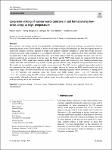Item Infomation
Full metadata record
| DC Field | Value | Language |
|---|---|---|
| dc.contributor.author | Hafssa, Tounsi | - |
| dc.contributor.author | Jonny, Rutqvist | - |
| dc.contributor.author | Mengsu, Hu | - |
| dc.date.accessioned | 2023-04-19T06:38:12Z | - |
| dc.date.available | 2023-04-19T06:38:12Z | - |
| dc.date.issued | 2023 | - |
| dc.identifier.uri | https://link.springer.com/article/10.1007/s11440-023-01900-w | - |
| dc.identifier.uri | https://dlib.phenikaa-uni.edu.vn/handle/PNK/8074 | - |
| dc.description | CC BY | vi |
| dc.description.abstract | Rock salt has a self-sealing capacity, low permeability, and high thermal conductivity, making it a potential host for heat-generating nuclear waste. The feasibility of nuclear waste disposal within salt formations has been investigated mostly for small-sized canisters. Geologic disposal of larger-sized canisters originally designed for spent fuel storage and transportation has lately been examined as a cost-effective alternative. This raises questions about their long-term vertical movement due to their weight and high decay heat. Low-stress creep governs this movement; however, most salt constitutive models do not incorporate it. In this paper, the Norton and the WIPP creep models are compared with the Lux/Wolters/Lerche (LWL) model and a simpler model that combines linear and Norton creep laws (named combined creep model). | vi |
| dc.language.iso | en | vi |
| dc.publisher | Springer | vi |
| dc.subject | Long-term sinking | vi |
| dc.subject | low-stress creep | vi |
| dc.title | Long-term sinking of nuclear waste canisters in salt formations by low-stress creep at high temperature | vi |
| dc.type | Book | vi |
| Appears in Collections | ||
| OER - Kỹ thuật điện; Điện tử - Viễn thông | ||
Files in This Item:

